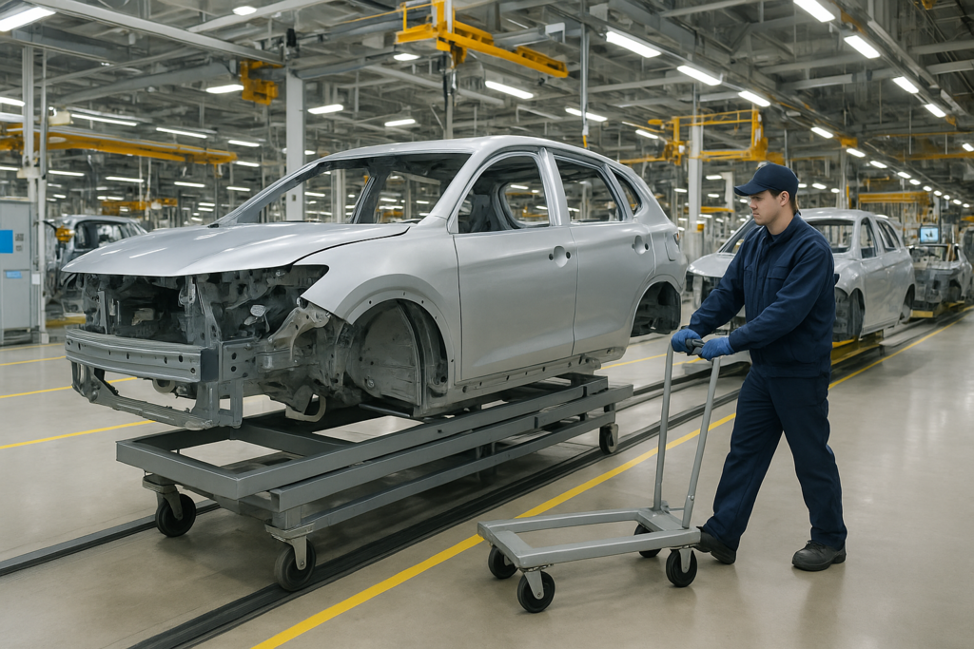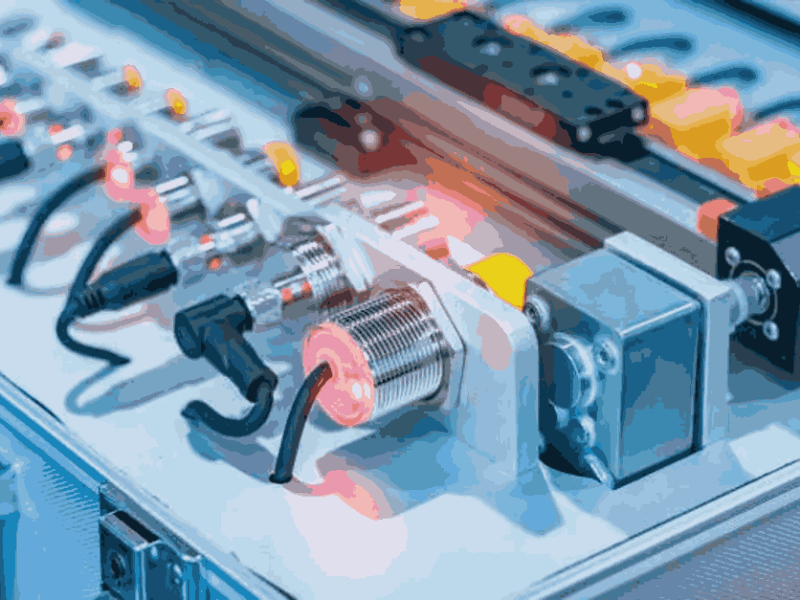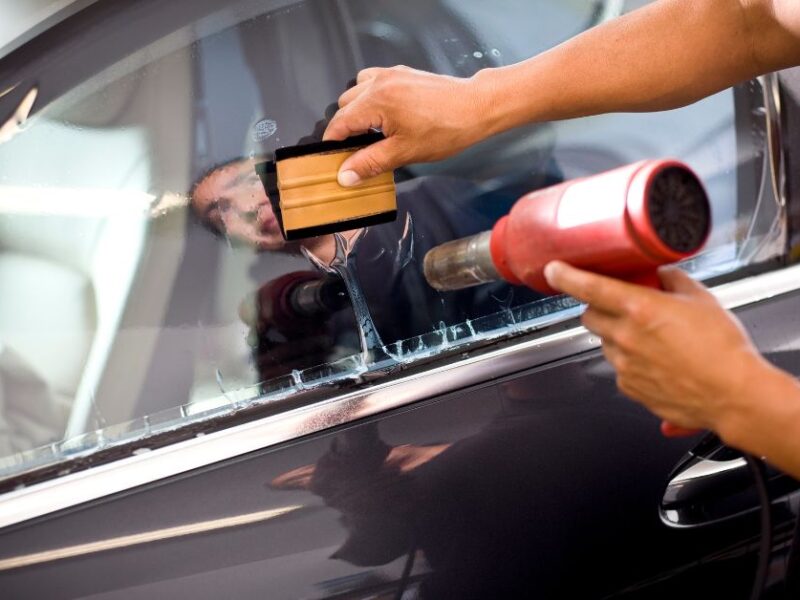Efficiency is the lifeblood of any automotive manufacturing process. From stamping and welding to painting and final assembly, each stage of vehicle production depends on smooth movement, precision timing, and reliable equipment. Among the many factors that influence operational performance, one of the most overlooked yet critical components is mobility — specifically, the use of the right casters and swivel casters.
In a setting where hundreds of parts, tools, and machines must move seamlessly every hour, the right mobility solution can significantly enhance productivity, reduce downtime, and improve worker safety. This article explores how proper caster selection can improve efficiency on automotive assembly lines, examines the trade-offs in design choices, discusses the engineering and ergonomic challenges, and emphasizes why decision-makers must consider both immediate performance and long-term impact when specifying mobility components.
Table of Contents
The Role of Mobility in Automotive Manufacturing
Automotive assembly lines are complex ecosystems that rely on the coordinated movement of materials, components, and workers. Every minute counts, and bottlenecks can ripple across production stages, leading to costly delays. In these environments, mobility isn’t a luxury — it’s a necessity.
Carts, tool stands, trolleys, part racks, and work platforms are constantly in motion. Operators depend on these mobile units to move components between stations quickly and safely. This mobility depends on an array of wheels and supports, with caster wheels at the core of the system. These components must endure heavy loads, operate on a variety of surfaces, and perform under demanding conditions, including exposure to oil, debris, or temperature fluctuations.
When the right caster is selected for the right task, it reduces friction, requires less force to move, and keeps production flowing smoothly. Conversely, poor caster selection can lead to premature wear, excessive vibration, increased push and pull forces, and in some cases, complete operational downtime due to mobility failures.
The Science Behind Efficient Movement
To understand how caster wheels influence assembly-line efficiency, it helps to look at their basic mechanics. A caster typically includes a wheel, a fork or rig, a bearing system, and a mounting plate. The combination of these elements determines how easily equipment moves and turns.
When engineers or maintenance teams choose mobility systems for automotive applications, they are essentially balancing three performance goals:
- Ease of movement – minimizing rolling resistance and effort.
- Load-bearing capacity – ensuring durability under high weight.
- Directional control – maintaining stability during transport or alignment.
Different manufacturing zones prioritize these factors differently. For example, body shop areas may emphasize heavy-duty durability for tool carts, while paint or trim areas might require smooth, vibration-free motion to protect delicate finishes.
Why Caster Selection Matters in Automotive Assembly Lines
Selecting the correct caster wheel may appear to be a simple purchasing decision, but it is a strategic engineering choice that affects the entire workflow. The right design improves throughput, safety, and ergonomics, while the wrong one can create hidden inefficiencies that accumulate over time.
1. Ergonomics and Worker Safety
Workers frequently move parts weighing hundreds of pounds on wheeled equipment. If these wheels have high rolling resistance, operators must exert greater force, increasing the risk of fatigue and musculoskeletal injury. Over time, this not only lowers productivity but also increases the likelihood of workplace incidents and compensation claims.
Well-designed caster wheels can dramatically lower push and pull forces, allowing operators to move heavy equipment with minimal effort. This is achieved through advanced wheel materials, optimized bearings, and designs that reduce vibration and surface drag. By investing in ergonomic mobility solutions, manufacturers ensure both productivity and employee wellbeing.
2. Reduced Downtime and Maintenance
Downtime is among the most expensive challenges in automotive manufacturing. A single failed wheel can immobilize a cart carrying critical components, halting an entire section of the production line. Quality casters with robust bearings and proper materials reduce the frequency of breakdowns.
Moreover, many manufacturers underestimate how surface compatibility impacts maintenance cycles. For instance, using hard wheels on smooth concrete floors may cause floor wear, while soft wheels can deform under heat or load. Choosing the right wheel compound based on the operating surface can prevent costly floor damage and reduce replacement intervals.
3. Space Optimization and Workflow Fluidity
In modern automotive plants, space efficiency is critical. Facilities are often designed to support lean manufacturing principles, where every inch of workspace must serve a purpose. Caster selection directly affects maneuverability, allowing equipment to fit and move through tight spaces efficiently.
Rotating casters, also known as 360-degree casters, are particularly valuable in these settings. Their ability to swivel freely enables operators to pivot and align carts quickly in constrained areas, minimizing time lost to repositioning. However, using too many rotating units can reduce stability, leading to oscillation or “caster flutter” — a trade-off that requires careful design balance between fixed and swiveling units.
Balancing Trade-Offs in Caster Design
The pursuit of mobility efficiency involves continuous trade-offs between competing engineering goals. Every design decision — from wheel material to bearing type — influences performance in different ways.
1. Load Capacity vs. Maneuverability
Heavy-duty wheels can carry significant weight, but they are typically larger and require more effort to initiate movement. In contrast, smaller wheels move more easily but cannot handle the same load. Automotive plants often need to balance these priorities, selecting caster wheels that deliver both strength and agility.
2. Durability vs. Floor Protection
Steel or cast-iron wheels are extremely durable and suitable for high loads but can damage factory floors and generate noise. Polyurethane or rubber compounds, while gentler and quieter, may wear faster or be less resistant to oils and solvents. Manufacturers must evaluate which trade-off better aligns with their environment and budget.
3. Swivel Precision vs. Stability
Rotating casters enhance maneuverability but can reduce directional stability at high speeds or on uneven surfaces. If carts oscillate or drift when towed, it may cause alignment issues or collisions. Engineers often address this by combining fixed casters on one side with rotating casters on the other, achieving a hybrid design that balances steering control and flexibility.
4. Cost vs. Lifecycle Value
Cheaper components may appear cost-effective initially but often fail more quickly under industrial stress, leading to higher long-term expenses. Investing in quality casters with sealed bearings, corrosion-resistant materials, or precision machining extends service life and reduces downtime — delivering better value across the product lifecycle.
Materials Matter: The Science of Wheel Composition
Different areas of automotive assembly present distinct environmental challenges. Selecting the right wheel material can optimize performance and longevity.
- Polyurethane Wheels: Offer a balance of durability and floor protection. Excellent for general-purpose carts and tools in assembly areas.
- Rubber Wheels: Ideal for noise-sensitive zones, but may wear faster under heavy loads.
- Nylon or Glass-Filled Nylon: Provide chemical resistance and strength with low rolling resistance. Suitable for paint or chemical exposure zones.
- Phenolic Resin Wheels: Heat-resistant and excellent for dry, high-temperature environments.
- Steel and Cast Iron: Used in heavy-duty applications, such as moving large dies or machinery, where load-bearing capacity is paramount.
The ideal selection depends not only on load but also on speed, frequency of movement, and exposure to elements like oil or temperature. Selecting mismatched materials can lead to rapid wear or floor damage, counteracting the intended efficiency gains.
Bearings and Their Influence on Efficiency
Another subtle but crucial factor in caster performance lies in the bearings. Bearings determine how smoothly a wheel turns under load, directly influencing the force needed to start and maintain movement.
- Plain bearings are cost-effective but create higher friction.
- Roller bearings reduce friction and handle heavy loads well.
- Precision ball bearings offer the smoothest rolling performance, ideal for high-frequency movement on assembly lines.
While precision bearings increase initial cost, their long-term benefit lies in lower energy expenditure, smoother motion, and reduced strain on operators and mechanical tuggers.
Ergonomic Design and Human Factors
Ergonomics is increasingly at the center of modern manufacturing strategy. When designing or retrofitting assembly carts, companies now consider not just speed or load but also how design affects human movement.
Push/pull force is a measurable factor: the amount of force an operator must exert to start or sustain movement. Ergonomic caster wheels minimize this force, often through advanced bearing design, wheel tread geometry, or swivel head precision.
Lower push/pull forces translate directly into fewer injuries, less fatigue, and higher daily productivity. When multiplied across hundreds of workers, even small improvements yield major efficiency gains.
Another ergonomic factor involves vibration. Excessive vibration during movement — often caused by hard wheels or uneven floors — can cause discomfort or fatigue. Choosing softer tread materials or spring-loaded casters mitigates this problem.
Environmental and Safety Considerations
Automotive plants operate in challenging environments. Temperature fluctuations, chemical exposure, and oil residue can degrade wheel materials if they aren’t properly chosen.
For instance, in paint shops, wheels must resist solvents; in welding areas, they should tolerate sparks or heat; in battery assembly zones, static-dissipative wheels may be required to prevent electrical discharge. Failing to match materials with conditions can lead to premature wear, safety hazards, or product contamination.
Additionally, modern plants are emphasizing sustainability. Selecting recyclable materials, long-lasting wheel compounds, and low-maintenance designs supports environmental goals while reducing overall lifecycle waste.
The Challenge of Customization
While standard caster models meet most needs, automotive assembly often demands customization. Equipment may have unique mounting configurations, specialized load requirements, or space limitations. Custom engineering ensures casters fit perfectly within operational constraints.
However, customization introduces its own challenges. Lead times are longer, design validation requires collaboration between vendors and engineers, and cost per unit is higher. The trade-off is that a tailored solution can deliver optimal efficiency, longer service life, and reduced ergonomic risk — benefits that often justify the investment.
Maintenance and Lifecycle Management
Efficiency doesn’t end with installation. Regular maintenance ensures caster systems continue to perform reliably. Preventive care includes checking bearings, cleaning debris, lubricating swivels, and inspecting wheel treads for wear or deformation.
Neglecting maintenance can lead to small performance losses that accumulate over time — carts that take slightly longer to move, operators who struggle more to align equipment, and bearings that gradually seize. These incremental inefficiencies eventually manifest as noticeable slowdowns in assembly flow.
Implementing a maintenance schedule or including caster inspection in daily safety checks can prevent unplanned stoppages and extend product lifespan.
Integrating Automation and Smart Mobility
The next generation of automotive assembly is increasingly automated. Automated guided vehicles (AGVs) and collaborative robots now handle many transport tasks once managed by human operators. Caster technology must evolve accordingly.
Rotating casters compatible with AGVs require precise tracking and low resistance to ensure accurate navigation. Some manufacturers are developing smart caster systems with sensors that monitor load, temperature, and motion. This data helps predict maintenance needs and optimize traffic patterns across factory floors.
Integrating intelligent caster systems may seem futuristic, but for automotive manufacturers aiming for zero downtime and predictive maintenance, such innovations are already becoming essential.
The Economic Impact of the Right Mobility Solution
While the focus is often on productivity, the financial benefits of the right caster system are equally significant. By reducing maintenance costs, minimizing injuries, preventing floor damage, and extending equipment lifespan, manufacturers can achieve measurable returns.
Consider an example: if an assembly line operates 250 days per year, and improved caster selection saves each operator just five minutes per shift, that equates to hundreds of labor hours saved annually. Multiply this across teams, and the cost savings quickly surpass the initial investment in high-performance components.
Balancing Innovation with Practicality
While advanced materials and smart systems offer exciting possibilities, manufacturers must ensure that upgrades align with practical realities. The ideal solution often lies in balancing innovation with simplicity — choosing products that integrate easily into existing equipment, require minimal retraining, and deliver consistent results.
Over-engineering a caster system can result in unnecessary cost and maintenance complexity, just as under-engineering can lead to inefficiencies. Therefore, engineering and procurement teams should collaborate closely, evaluating real-world operating conditions before finalizing specifications.
Final Thoughts: A Small Component with a Major Impact
Casters and swivel casters might appear insignificant compared to the robotics, conveyors, and precision machinery that define automotive assembly lines. Yet these components form the foundation of operational mobility — the invisible enabler of efficient production.
Selecting the right caster wheels, materials, and bearing configurations can transform workflow fluidity, reduce operator strain, and prevent costly downtime. The trade-offs between load capacity, durability, ergonomics, and cost are complex, but when balanced thoughtfully, the results are unmistakable: faster operations, safer working conditions, and long-term economic gains.
In an industry driven by precision and speed, even the smallest improvements in mobility can have a profound ripple effect across production. The right mobility solutions ensure that every cart, rack, and workstation moves as efficiently as the vehicles they help assemble — keeping the entire operation rolling smoothly toward success.


